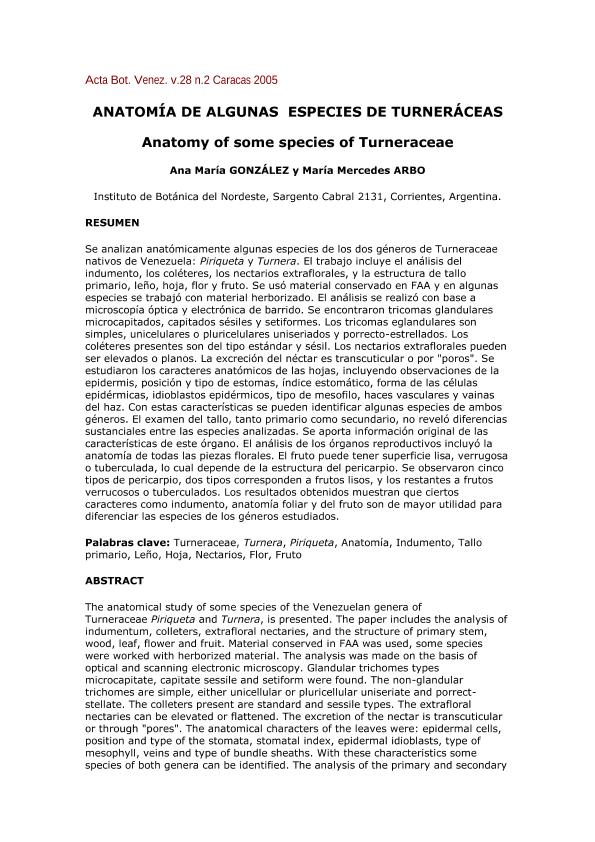Artículo
Se analizan anatómicamente algunas especies de los dos géneros de Turneraceae nativos de Venezuela: Piriqueta y Turnera. El trabajo incluye el análisis del indumento, los coléteres, los nectarios extraflorales, y la estructura de tallo primario, leño, hoja, flor y fruto. Se usó material conservado en FAA y en algunas especies se trabajó con material herborizado. El análisis se realizó con base a microscopía óptica y electrónica de barrido. Se encontraron tricomas glandulares microcapitados, capitados sésiles y setiformes. Los tricomas eglandulares son simples, unicelulares o pluricelulares uniseriados y porrecto-estrellados. Los coléteres presentes son del tipo estándar y sésil. Los nectarios extraflorales pueden ser elevados o planos. La excreción del néctar es transcuticular o por "poros". Se estudiaron los caracteres anatómicos de las hojas, incluyendo observaciones de la epidermis, posición y tipo de estomas, índice estomático, forma de las células epidérmicas, idioblastos epidérmicos, tipo de mesofilo, haces vasculares y vainas del haz. Con estas características se pueden identificar algunas especies de ambos géneros. El examen del tallo, tanto primario como secundario, no reveló diferencias sustanciales entre las especies analizadas. Se aporta información original de las características de este órgano. El análisis de los órganos reproductivos incluyó la anatomía de todas las piezas florales. El fruto puede tener superficie lisa, verrugosa o tuberculada, lo cual depende de la estructura del pericarpio. Se observaron cinco tipos de pericarpio, dos tipos corresponden a frutos lisos, y los restantes a frutos verrucosos o tuberculados. Los resultados obtenidos muestran que ciertos caracteres como indumento, anatomía foliar y del fruto son de mayor utilidad para diferenciar las especies de los géneros estudiados. The anatomical study of some species of the Venezuelan genera of Turneraceae Piriqueta and Turnera, is presented. The paper includes the analysis of indumentum, colleters, extrafloral nectaries, and the structure of primary stem, wood, leaf, flower and fruit. Material conserved in FAA was used, some species were worked with herborized material. The analysis was made on the basis of optical and scanning electronic microscopy. Glandular trichomes types microcapitate, capitate sessile and setiform were found. The non-glandular trichomes are simple, either unicellular or pluricellular uniseriate and porrect-stellate. The colleters present are standard and sessile types. The extrafloral nectaries can be elevated or flattened. The excretion of the nectar is transcuticular or through "pores". The anatomical characters of the leaves were: epidermal cells, position and type of the stomata, stomatal index, epidermal idioblasts, type of mesophyll, veins and type of bundle sheaths. With these characteristics some species of both genera can be identified. The analysis of the primary and secondary stem does not reveal substantial differences among the analysed species. Original information of the characteristics of this organ is provided. The analysis of the reproductive organs included the anatomy of all the floral pieces. The presence and combination of these characters, in addition to other features like fruit anatomy, allow the characterisation of different taxa in both genera. The fruit surface can be flat, warty or tuberculated, which depends on the structure of the pericarp. Seven pericarp types were observed, two types correspond to flat fruits, and the rest to warty or tuberculated fruits. The results show that certain characters like indument, foliar and fruit anatomy are of greater utility to differentiate the species from the studied genera.
Anatomía de algunas especies venezolanas de Turneraceae
Título:
Anatomy of some species of Turneraceae
Fecha de publicación:
12/2005
Editorial:
Fundación Instituto Botánico de Venezuela Dr. Tobias Lasser
Revista:
Acta Botanica Venezuelica
ISSN:
0084-5906
Idioma:
Español
Tipo de recurso:
Artículo publicado
Clasificación temática:
Resumen
Archivos asociados
Licencia
Identificadores
Colecciones
Articulos(IBONE)
Articulos de INST.DE BOTANICA DEL NORDESTE (I)
Articulos de INST.DE BOTANICA DEL NORDESTE (I)
Citación
González, Ana María; Arbo, Maria Mercedes; Anatomía de algunas especies venezolanas de Turneraceae; Fundación Instituto Botánico de Venezuela Dr. Tobias Lasser; Acta Botanica Venezuelica; 28; 2; 12-2005; 369-394
Compartir




